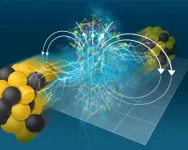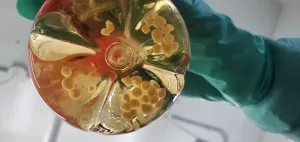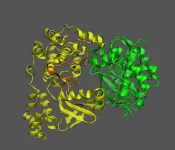(Press-News.org) “Practice makes perfect” is no mere cliché, according to a new study from researchers at The Rockefeller University and UCLA. Instead, it’s the recipe for mastering a task, because repeating an activity over and over solidifies neural pathways in your brain.
As they describe in Nature, the scientists used a cutting-edge technology developed by Rockefeller’s Alipasha Vaziri to simultaneously observe 73,000 cortical neurons in mice as the animals learned and repeated a given task over two weeks. The study revealed that memory representations transform from unstable to solid in working memory circuits, giving insights into why performance becomes more accurate and automatic following repetitive practice.
“In this work we show how working memory—the brain’s ability to hold and process information—improves through practice,” says Vaziri, head of Rockefeller’s Laboratory of Neurology and Biophysics. “We expect that these insights will not only advance our understanding of learning and memory but also have implications for addressing memory-related disorders.”
Imagining challenges
Working memory is essential to a variety of cognitive functions, and yet the mechanisms underlying memory formation, retention, and recall—which enable us to perform a task we’ve done before without having to learn it anew—remain unclear over long timescales.
For the current study, the researchers wanted to observe the stability of working memory representations over time, and what role these representations played in the ability to skillfully perform the task on cue. To do so, they sought to record neuronal populations repeatedly in mice over a relatively long period while the animals learned and became experts in a given task.
But they faced a daunting challenge: technical limitations have hampered the ability to image the activity of large population of neurons across the brain in real time, over longer periods, and at any tissue depth in the cortex.
The UCLA researchers turned to Vaziri, who has developed brain imaging techniques that are among the only tools capable of capturing the majority of the mouse cortex in real time at a high resolution and speed.
Vaziri suggested they use light-beads microscopy (LBM), a high-speed volumetric imaging technology he developed that allows for cellular resolution in vivo recording of activity of neuronal populations up to 1 million neurons—a 100-fold increase in the number of neurons that can be simultaneously recorded.
Neural transformations
In the current study, the researchers used LBM to image the cellular activity of 73,000 neurons in mice simultaneously throughout various depths of the cortex and tracked the activity of the same neurons over two weeks as the animals identified, recalled, and repeated a sequence of odors.
They found that the working memory circuits transformed as the mice mastered the proper sequences. Initially, the circuits were unstable, but as the mice practiced the task repeatedly, the circuits began to stabilize and solidify.
“This is what we refer to as ‘crystallization,’” Vaziri says. “The findings essentially illustrate that repetitive training not only enhances skill proficiency but also leads to profound changes in the brain’s memory circuits, making performance more accurate and automatic.”
“If one imagines that each neuron in the brain is sounding a different note, the melody that the brain is generating when it is doing the task was changing from day to day, but then became more and more refined and similar as animals kept practicing the task,” adds corresponding author and UCLA Health neurologist Peyman Golshani.
Crucially, some aspects of these discoveries were uniquely enabled by the large-scale and deep tissue imaging capabilities of LBM. Initially, the researchers used standard two-photon imaging of smaller neuronal populations in upper cortical layers, but they failed to find evidence for memory stabilization. But once they employed LBM to record from over 70,000 neurons in deeper cortical regions, they were able to observe the crystallization of working memory representations that accompanied the mice’s increasing mastery of the task.
“In the future, we may tackle the role of different neuronal cell types involved in mediating this mechanism, and in particular the interaction of different types of interneurons with excitatory cells,” Vaziri says. “We’re also interested in understanding how learning is implemented and could be transferred into a new context—that is, how the brain could generalize from a learned task to some new unknown problems.”
END
How memories crystallize over time
2024-05-17
ELSE PRESS RELEASES FROM THIS DATE:
Gilbert Family Foundation invests $21 million to launch new research initiative focused on developing advanced disease models to accelerate cure for neurofibromatosis
2024-05-17
New initiative, launched on World NF Awareness Day, focuses on developing improved models to understand neurofibromatosis type 1 (NF1) with the goal of rapidly testing new treatments.
18 grants will be provided to leading medical research institutions in the United States and Europe.
The Next-Generation NF1 Models Initiative is the Foundation’s fourth research initiative focused on accelerating a cure for neurofibromatosis.
DETROIT, May 17, 2024 – Gilbert Family Foundation, a private foundation established by Dan and Jennifer Gilbert to accelerate a cure for ...
Multiple onychopapillomas and BAP1 tumor predisposition syndrome
2024-05-17
About The Study: This study found that BRCA1-associated protein (BAP1) tumor predisposition syndrome was associated with a high rate of nail abnormalities consistent with onychopapillomas (a benign tumor of the nail) in adult carriers of the disease. Findings suggest that this novel cutaneous sign may facilitate detection of the syndrome in family members who are at risk and patients with cancers associated with BAP1 given that multiple onychopapillomas are uncommon in the general population and may be a distinct clue to the presence of a pathogenic germline variant in the BAP1 gene.
Corresponding Authors: To contact the corresponding authors, ...
Researchers confirm scale matters in determining vulnerability of freshwater fish to climate changes
2024-05-17
The silver chub isn’t considered sensitive to climate change on a national scale, but context matters. For example, if climate change sensitivity is evaluated in only one region of the United States, the freshwater fish appears quite a bit more susceptible.
“Relative to other species we looked at in the gulf region of the U.S., the silver chub occupied a pretty small geographic area,” said Samuel Silknetter, a Ph.D. student in biological sciences. “If we didn’t look at the climate sensitivity across multiple ...
Sweet taste receptor affects how glucose is handled metabolically by humans
2024-05-17
PHILADELPHIA (May 16, 2024) – The rich research portfolio of the Monell Chemical Senses Center on sweet taste goes way back: Monell scientists were one of four teams in 2001 that found and described the mammalian sweet taste receptor – TAS1R2-TAS1R3. Twenty years later in 2021, a pair of papers published in Mammalian Genome by Monell researchers covered the genetics of sugar-loving mice.
The sweet taste receptor, expressed in taste bud cells, conveys sweetness from the mouth when it is activated. Earlier this month, a study in PLOS One, led by another Monell researcher, delved into how the sweet-taste receptor might be the first stop ...
STAR sees a magnetic imprint on deconfined nuclear matter
2024-05-17
The Science
Scientists have the first direct evidence that the powerful magnetic fields created in off-center collisions of atomic nuclei induce an electric current in “deconfined” nuclear matter. This is a plasma “soup” of quarks and gluons that have been set free, or “deconfined,” from nuclear matter—protons and neutrons—in the particle collisions. The magnetic fields in deconfined nuclear matter are a billion times stronger than a typical refrigerator magnet, but their effects can be hard to detect. This new study’s evidence is from measuring the way ...
CU faculty member receives prestigious award for health equity work
2024-05-17
In recognition of her exceptional work in advancing health equity, the Society of General Internal Medicine (SGIM) bestowed its 2024 Herbert W. Nickens Award to Rita Lee, MD, a University of Colorado Department of Medicine faculty member, at a May 17 meeting in Boston.
“The committee has chosen to honor you as an exemplary SGIM member who has made prioritizing minority health and diversity the primary focus of your career,” Alana Biggers, MD, MPH, the chair of the award selection committee, said in a congratulatory letter to Lee.
The ...
Better medical record-keeping needed to fight antibiotic overuse, studies suggest
2024-05-17
A lack of detailed record-keeping in clinics and emergency departments may be getting in the way of reducing the inappropriate use of antibiotics, a pair of new studies by a pair of University of Michigan physicians and their colleagues suggests.
In one of the studies, about 10% of children and 35% of adults who got an antibiotic prescription during an office visit had no specific reason for the antibiotic in their record.
The rate of this type of prescribing is especially high in adults treated seen in emergency departments and in adults seen in clinics who have Medicaid coverage or no insurance, the ...
Clinicians report success with first test of drug in a patient with life-threatening blood clotting disorder
2024-05-17
Key Takeaways
Immune thrombotic thrombocytopenic purpura, a rare blood clotting disorder, results from an autoimmune attack against an enzyme called ADAMTS13
A recombinant form of human ADAMTS13 approved for a different condition helped to save the life of a young mother with immune thrombotic thrombocytopenic purpura
Results from this first use of the drug for this condition—by a team led by researchers from Massachusetts General Hospital—warrants testing the drug in a clinical trial
A team led by investigators from Massachusetts General Hospital, a founding member of the Mass General Brigham healthcare system, used a new drug to save the life of a patient ...
NIH study shows chronic wasting disease unlikely to move from animals to people
2024-05-17
WHAT:
A new study of prion diseases, using a human cerebral organoid model, suggests there is a substantial species barrier preventing transmission of chronic wasting disease (CWD) from cervids—deer, elk and moose—to people. The findings, from National Institutes of Health scientists and published in Emerging Infectious Diseases, are consistent with decades of similar research in animal models at the NIH’s National Institute of Allergy and Infectious Diseases (NIAID).
Prion diseases are degenerative diseases found in some mammals. These diseases primarily involve deterioration of the brain but also can affect the eyes and other organs. ...
Scientists discover mechanism of sugar signaling in plants
2024-05-17
UPTON, N.Y. — Proteins are molecular machines, with flexible pieces and moving parts. Understanding how these parts move helps scientists unravel the function a protein plays in living things — and potentially how to change its effects. Biochemists at the U.S. Department of Energy’s (DOE) Brookhaven National Laboratory and colleagues at DOE’s Pacific Northwest National Laboratory (PNNL) have just published a new example of how one such molecular machine works.
Their paper in the journal Science Advances describes how the moving parts of ...




